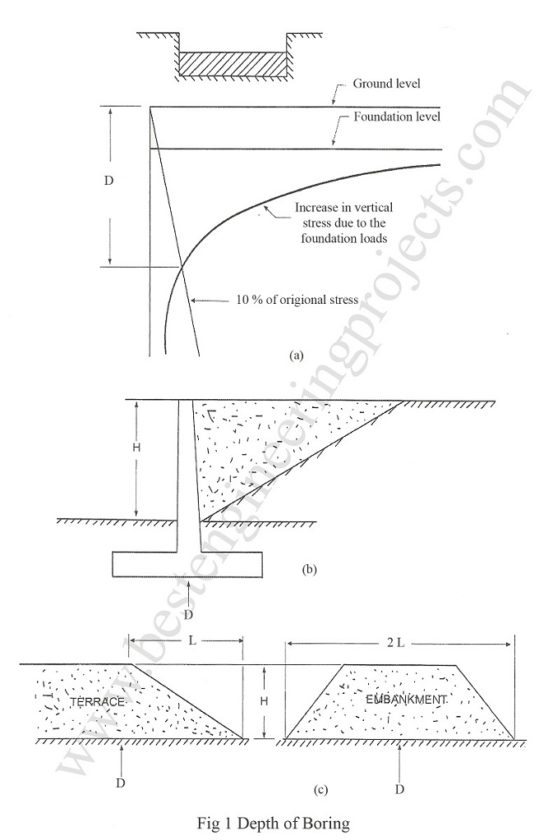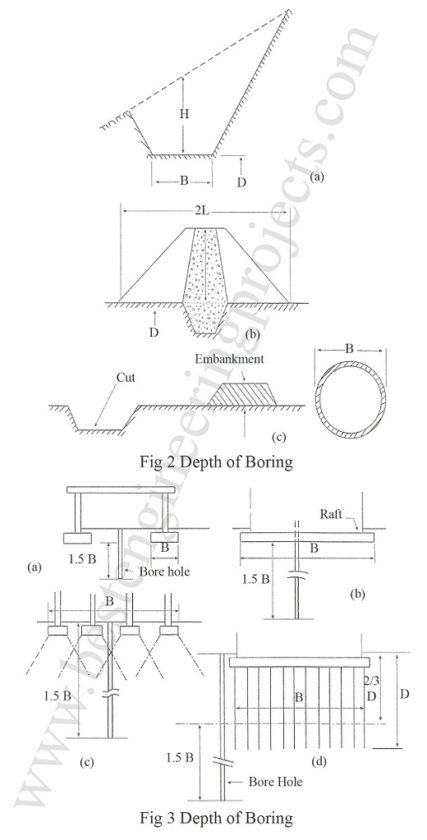Introduction to Depth of Boring:
In this article we will discuss about Depth of boring and depth of boring bore log. The depth of soil affected by the load transmitted by the foundation determines the required depth of boring in the overall process. The additional stresses imposed by the foundation to a depth of one and half times the total width of foundation is still found to be about 20% below the foundation base.
At the depth equal to two times the width of foundation, this stress is about 10%. Considering the effect of stress felt, the boring should be always taken to a depth at least equal to one and half times of the foundation width below the base of the foundation. The depth of boreholes to be made under different foundation conditions are shown in Fig 1, 2 and 3. some additional information regarding the depth of boring can be obtained from the table 1 given below.
Table 1 Depth of Boring According as Structure Type
|
S.N |
Structure type |
Design Consideration |
Depth of Boring |
Remark |
|
1 |
Building |
Settlement, total and differential |
10 m minimum, or up to depth where the increase in stress due to structure is 10% of stress imposed by structure |
D = depth of exploration in [fig. 2.14(a)] |
|
2 |
Retaining walls |
Bearing capacity and settlement |
D = 0.5 to 2H |
D = depth of hole and H = height of wall [fig. 2.14(b)] |
|
3 |
Terraces and fill |
Bearing capacity and settlement |
D = 1.25 L for terraces and 0.5 L for fill |
D = depth of exploration and L = projected slope length [fig. 2.14(c)] |
|
4 |
Depth cuts |
Stability of slopes |
D = 0.75 B to 1.0 B |
D = depth of exploration and B = bottom width of cut [fig. 2.15(a)] |
|
5 |
Earth dam and levee |
Bearing capacity |
D = L |
D = depth of exploration and B = bottom width of dam [fig. 2.15(b)] |
|
6 |
Concrete dam |
Bearing capacity |
D = 1.5 to 2H |
D = depth of exploration and H = height of dam |
|
7 |
Highways, railways and airports |
General stability and drainage conditions |
1 to 2 m for light loads and 2 to 3.5 m for heavy loads |
|
|
8 |
Tunnels |
Stability of materials and pressure exerted against tunnel lining |
D = B |
D = depth of exploration and B = gross width of tunnel |
Bore Logs
A detailed record of boring operations and other tests carried out in the field is an essential part of the field work. The bore hole log is made during the boring operation. The soil is classified based on the visual examination of the disturbed samples collected. A typical example of a bore hole log is given in Table 2
Table 2
| Job No Date: |
|
Project: BH NO:
Location: GL:
Boring Method WTL:
Dia of BH: Supervisor:
|
|
Soil Type |
|
LEVEL m |
Depth m |
SPT |
Sample type |
Remark |
|||
|
15 cm |
15 cm |
15 cm |
N |
||||||
|
Yellowish Stiff clay
|
|
|
|
|
|
|
|
|
|
|
Greyish sandy silt medium dense
|
|
||||||||
|
Greyish silt sand dense
|
|
||||||||
|
Blackish very stiff clay
|
|
||||||||

